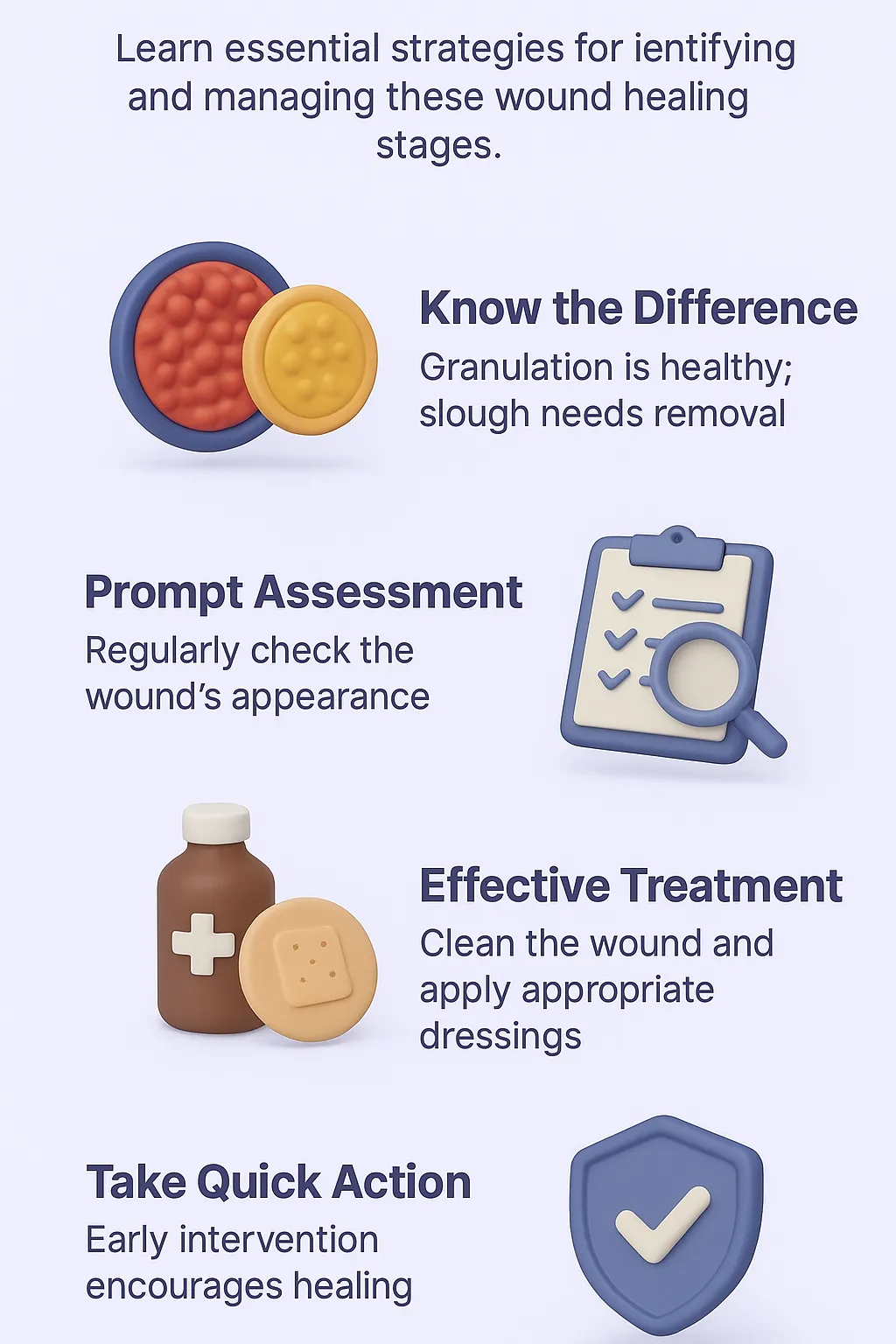In wound care, distinguishing between granulation tissue and slough is more than a visual skill—it’s a critical step that directly influences healing speed and overall outcomes. Granulation tissue signals healthy progress, while slough can hide infection risk and slow recovery. In this guide, you’ll learn practical assessment methods, subtle indicators often overlooked in textbooks, and treatment strategies proven effective in real-world settings, including how to evaluate a granulation tissue slough wound.
Top Takeaways
- Granulation vs. Slough: Healthy red/pink vs. yellow/tan/white.
- Respond Quickly: Remove or manage slough early to maintain healing momentum.
- Watch Closely: Even minor shifts in color or texture may indicate problems.
- Choose the Right Care: Select dressings that match the wound’s unique needs.
- Work With Experts: Regular professional evaluations keep wounds progressing.
Identifying Granulation Tissue and Slough
Correct identification can drastically shorten recovery time.
- Granulation tissue is moist, red or pink, and filled with tiny new capillaries that rebuild the wound bed—clear signs of forward healing.
- Slough is soft, yellow, tan, or white, and often stringy. Made up of dead cells and debris, it can delay closure and may require debridement.
A consistent wound care routine should include:
- Frequent visual inspection
- Tracking changes in tissue appearance and moisture
- Adjusting care plans as soon as changes are detected
“From years in wound care, I’ve learned that a subtle shift—from bright red granulation to pale yellow slough—can completely change a healing plan and outcome.”
Case Study & Real-World Examples: Lessons from the Field
Case Study – Preventing a Healing Stall in a Pressure Ulcer
- Long-term care patient with healthy granulation tissue
- A small yellow-tan area appeared along the wound’s edge
- Recognized as early slough from experience—not harmless tissue
- Actions taken:
- Targeted cleansing
- Switched to a moisture-controlling dressing
- Staff trained to monitor daily
- Outcome: Slough cleared in 10 days; healing pace improved. Delay would have cost weeks
Real-World Observation – Color as the First Warning
- Healthy granulation: vibrant pink
- Early slough: dull, opaque yellow
- Change can happen within 24–48 hours
- Quick recognition prevents healing stalls
Research Backing
- Journal of Wound Care (2021): Removing slough early shortened chronic wound healing times by over 30%, aligning with real-world results
Supporting Statistics & Field Insights
- ~60,000 U.S. deaths annually are linked to pressure injuries – National Pressure Injury Advisory Panel
- 15% of Medicare patients have chronic nonhealing wounds—costing $28–$31B yearly – National Institutes of Health
Field Perspective: These numbers represent real people I’ve treated. Spotting and addressing slough early not only improves healing—it prevents unnecessary suffering and cost.
Final Thought & Opinion
- Key Point: Healing success often hinges on quickly telling granulation tissue from slough
- Impact: Waiting too long risks higher costs, longer recovery, and serious complications
- Experience Insight: Even the smallest visual change can signal the need to act
- Bottom Line: Real-world practice, not just protocol, drives the best healing results. In many cases, integrating advanced wound care treatments at the right time can significantly improve outcomes and speed the recovery process.
Next Steps
- Inspect daily for changes in color, texture, or moisture
- Document progress with notes or photos
- Intervene early if slough is present—don’t wait for worsening
- Select the right dressing for moisture and exudate needs
- Consult a wound care professional regularly
Educate caregivers to spot and respond to slough early
Frequently Asked Questions
What is the difference between granulation tissue and slough in wound care?
Granulation tissue is healthy new tissue, usually moist, red or pink, and slightly bumpy, indicating healing progress. Slough is yellow, tan, or white soft tissue made up of dead cells and debris, which can slow or stall healing if not managed.
Why is it important to recognize slough early?
Early detection of slough allows for timely intervention, such as cleansing or debridement, preventing healing delays, lowering infection risk, and improving outcomes.
How can I accurately identify granulation tissue and slough?
Look for differences in color and texture—granulation is vibrant and uniform, while slough appears dull, sticky or stringy, and may cover parts of the wound bed. Subtle shifts in appearance can indicate early slough formation.
What are the best treatment options for slough in wounds?
Treatment may include autolytic, enzymatic, or surgical debridement, combined with appropriate dressings to manage moisture and promote healthy tissue growth. Always consult a wound care professional before starting treatment.
Can granulation tissue and slough be present in the same wound?
Yes. A wound can have both granulation tissue and slough at the same time, often in different areas. Effective wound care requires targeting the slough without damaging the healthy granulation tissue.
When addressing recognize & treat granulation tissue, slough in wounds, it’s important to remember that optimal healing isn’t just about the right clinical approach—it also depends on creating a clean, safe environment that supports recovery. Reducing dust, allergens, and bacteria in your living space can help prevent secondary infections that complicate wound healing. Services like Dryer Vent Cleaning in Black Hammock, FL and regular system upkeep through AC Maintenance can improve indoor air quality significantly. High-performance filtration products such as the 16x24x1 Pleated Furnace Filters, the 20x20x1 MERV 11 Pleated HVAC AC Furnace Air Filters 4-Pack, and the 16x24x1 Air Filter on eBay further contribute to a healthier environment. By combining meticulous wound care practices with a cleaner home atmosphere, you can better manage granulation tissue and slough, ultimately supporting faster and more effective healing.







